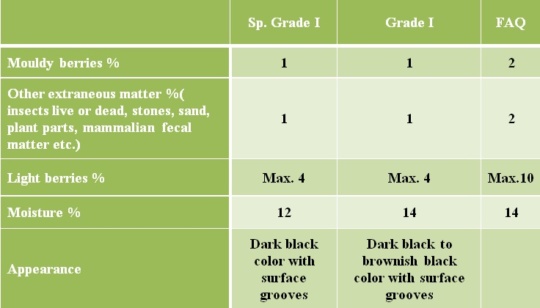Pepper is the most widely used spice in the world and known as “King of the Spices”. Pepper crop is native to South Asia and historical records reveal that pepper is originated in South India. Peppercorns were a much prized trade good often referred also as “black gold” and used by as a form of commodity money. Until well after the Middle age, virtually all of the black pepper found in Europe, the Middle East and the North Africa traveled there from South Asia region.
Uses
Pepper is largely produces as black pepper which is the dried whole fruit. White pepper is produced by removing outer pericarp and pepper is also available in crushed and ground forms. Small amount of green and ripened pepper is pickled in brine and dehydrated green pepper and preserved red pepper also traded. Pepper oil and oleoresins are also extracted marketed as value added products.
Pepper is mainly used as a spice and flavoring agent in food industry. It also has industrial uses in perfumery and pharmaceutical industries.
Major Growing Areas
In Sri Lanka pepper is mainly cultivated in Low and Mid country Wet and Intermediate agro-climatic zones. Total extent of pepper in Sri Lanka is about 29,378ha and Matale, Kandy, Kegalle,Badulla,Ratnapura, Monaragala and Kurunagala are the major districts.
Standard quality specifications
Quality standards approved by the Sri Lanka Standard Institute are given below

National and International quality specifications for Pepper
- Whole black pepper;
Whole black pepper shall be the dried whole corns or berries of nigrum L. generally picked before they are ripened. They are brown to black in color with deep set wrinkles on the dried berry.
- Whole white pepper;
Whole white pepper shall be the whole black pepper after ripening and which the outer coating or the pericarp has been removed and dried afterwards. - Light berries;
Light berries shall be those pepper corns which when subjected to the test prescribed in 9.3 float on the surface of the alcohol/water medium. - Pin heads:
Pin heads shall be the whole under developed corns of P. nigrum L. For the purpose of this standard, pepper corns passing through a 2.36 mm sieve and remaining on a 1.40 mm sieve shall be considered as pin heads. - Extraneous matter:
Extraneous matter shall be any material than those defined above; dust from pepper corns passing through 1.40 mm sieve shall be considered as extraneous matter for the purpose of this standard.
IPC Grade Specifications the European Union and a few countries such as USA and Japan have drawn up their own specifications for import of both black pepper and white pepper but there is lack of uniformity in the specifications prescribed by these importing countries. The International Pepper Community (IPC), with the participation of the member countries, has prepared a set of specifications for export of both black pepper and white pepper. These specifications cover the physical characteristics of the pepper, insect and microbial infestations, extraneous matter and mammalian and / or other excreta. Based on these parameters, IPC has specified two grades each for whole black pepper and whole white pepper. Grades of whole pepper, black and white Black Pepper (whole) White Pepper (whole) Quality Parameter
IPC BP-1 & IPC BP-2 (Black Pepper) IPC WP-1 & IPC WP-2 (White Pepper)

